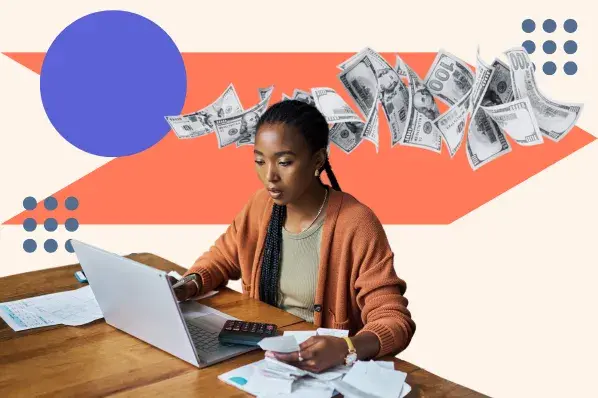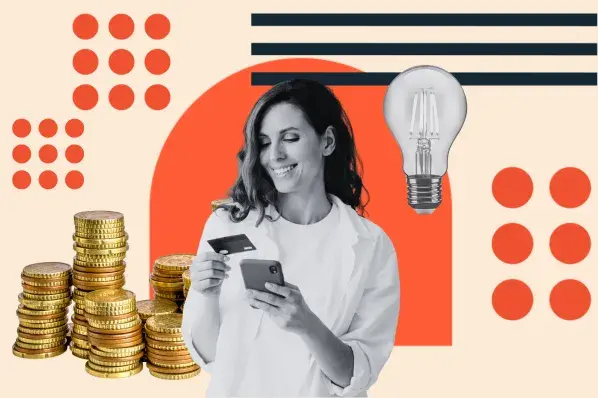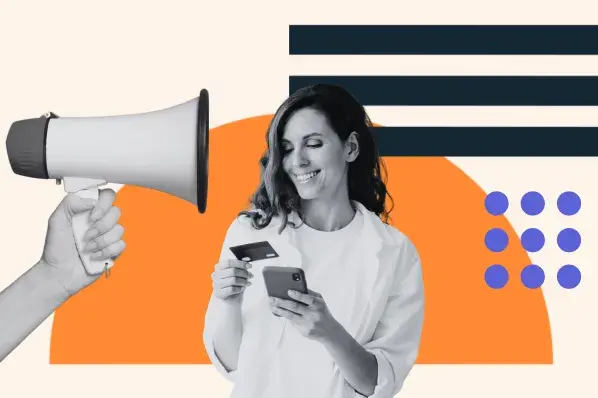That’s the power of a referral. When a friend recommends something like a restaurant, a song, or an app, we’re far more likely to give it a try. Referrals from loyal customers bring in new ones, and they tend to stick around. In fact, 30% of consumers report discovering new brands through word-of-mouth referrals.
Humans are wired for social proof. We implicitly look to others for cues on how to act and what’s worth our time and money, and you can leverage a referral program to transform that instinct into a reliable and scalable growth engine. In this post, I’ll break down how you can do the same for your business with a referral program.
Table of Contents
- What is a referral program?
- How to Create a Customer Referral Program
- How valuable is a referral?
- Benefits of Customer Referral Programs
- Customer Referral Program Ideas
- Referral Program Examples
A successful referral program leverages word-of-mouth marketing to transform loyal customers into brand advocates, attracting new customers, enhancing brand awareness, and driving revenue.
How do referral programs work?
A referral program rewards existing customers for referring new ones. Businesses typically manage these referrals with software that generates unique links and forms that can track which referrals result in conversions, ensuring rewards are given out accurately and automatically.
In my band, we’ve been experimenting with a more “analog” version of a referral program at shows. If a fan brings a friend who has never seen us before, they can both visit the merch table for free stickers, guitar picks, and the opportunity to purchase an exclusive tee reserved only for referrers and their guests.
It’s a simple program, but it works. I’ve noticed that it’s not just the free stuff that gets people to bring their friends — it’s the exclusivity. Fans (and customers) love being part of an inside circle, and that sense of access is what gets them excited to advocate on our behalf.
The same principles apply outside of music. Whether you’re selling software or cupcakes, the mechanics are the same. Referral programs provide a compelling reason for people to share. It can be discounts, freebies, or exclusive access. The only limit is your creativity, but the effect is always more advocacy, sales, and growth.
How valuable is a referral?
Referrals are extremely valuable. Studies show they generate, on average, five times more sales than paid media impressions. They don’t just bring in customers, they bring in better customers. Referred customers convert 30% more often, stay loyal 37% longer, and generate 16% more in LTV than those acquired through traditional marketing.
Brands that master word-of-mouth marketing and referrals don’t just gain customers; they build a self-sustaining growth engine of brand advocacy where each new customer can spark a chain reaction of new referrals.
At its peak, a referral program can foster a community of loyal brand advocates. I’ve seen this personally with my band. Our most loyal customers, our superfans, don’t just buy tickets and listen on Spotify. They share our music online, travel across the country to see us, and bring new people to shows. Some have even gone so far as to create independent fan clubs and social media pages just to spread the word about the band.
That kind of advocacy is priceless, and it’s within reach for any business with a great product that invests intelligently in a referral program.
1. Start with customer referral templates.
One thing I’ve learned from promoting my band and encouraging referrals is that you don’t have to reinvent the wheel every time you ask someone to share. That’s why I recommend starting with customer referral templates, like these free ones from HubSpot.
With my band, I’ll reuse language from previous referral request emails, text message campaigns, and social media posts. That way, I don’t have to start from scratch every time we make a referral push, and I can just slot in relevant details while retaining our brand voice.
HubSpot’s free referral templates offer the following resources to help you streamline your referral program:
- Referral request emails. A simple, effective way to ask customers to refer you.
- Referral follow-up emails. Because sometimes, people just need a little reminder.
- Social media copy. Quick, shareable posts to spread the word about your referral program.
- And more! The right templates keep your referral program running smoothly without you having to reinvent the wheel every time.
Templates save time and help you maintain consistent brand messaging. Using templates reduces the barrier to entry of your referral program and enables you to turn it into a repeatable, scalable process for driving growth.
2. Set your goals.
When I start a new project, the first thing I do is clearly outline my goals. When it came to a referral program for my band, my goal was to sell more tickets, increase merchandise sales, and attract new fans (i.e., drive growth and revenue).
Here are some things to consider when brainstorming a new referral program for your business:
- Do I want to drive revenue, growth, or both?
- Am I looking to increase both customer retention and acquisition?
- Does my industry require an exceptional amount of trust-building?
Without clear goals, you risk building a client referral program that doesn’t serve your business needs. Once you define your goals, you can craft a referral program around them, whether that means focusing on incentives, enhancing the customer experience, or building trust.
3. Research how referrals are coming to your business.
Referrals are like water; they follow the path of least resistance. Your job is to spot where the referral flow is coming from and capitalize on that. Before you start crafting your program, research how new customers find you and focus on the most effective channels for reaching them.
For my band, I noticed that new fans most often found us through word-of-mouth marketing, where fans would share our music with their friends and bring them to our shows. That insight made it clear to me that we needed to lean into a customer referral program that rewarded existing fans for spreading the word.
For other businesses, the “path of least resistance” might be different. It could be YouTube reviews, influencer tags, or organic social media posts. The key is to identify what’s already working and design your referral program to maximize it, rather than trying to create demand on channels that are already dry to begin with.
4. Determine what a “good fit” customer is for your company.
Not every referral is a good one. A “good fit” referral is someone who already matches the profile of your ideal customer, therefore making them likely to convert. A great referral program clearly defines those criteria so your advocates always send the right people your way.
In my band, I know that if someone’s into similar artists like Flipturn, Melt, or Ripe, they’ll probably connect with our music as well. By pairing that insight with demographic data from my existing fanbase, I can start crafting the profile of the perfect referral.
When you promote your referral program, make those criteria impossible to miss. Describe your referral profile in a quick line of copy or with a simple checklist. That way, your customers won’t just chuck in random names. Instead, they pre-qualify the right people. Done well, a referral program can turn your existing customers into lead-qualifying machines. Who needs a sales team, anyway?
5. List your possible referral sources.
Your existing customers are your primary source of referrals. I think that’s pretty clear. However, that’s not the main takeaway. Instead of just knowing that customers can refer you, the key is figuring out which ones are most likely to actually do it. Additionally, consider other individuals who aren’t customers but have a vested interest in your growth.
For your business, consider the following:
- Who’s most motivated to refer you? Your happiest and most loyal customers, as well as partners who benefit from your growth.
- Who has reach? Are you connected with any influencers or leaders in your industry?
- Who’s already sharing? Do you have customers who already post about you without being asked? Reward them handsomely, and interview them to build a profile of ideal referrers.
As I’ve mentioned, my band’s most significant source of referrals is our existing fanbase. However, we’ve also gained traction through word-of-mouth from other bands we’ve toured with, as well as from engineers and producers we’ve worked with in the studio.
My point is, don’t limit your program to customers alone. Think outside the box and consider everyone who is allied to your business — fans, peers, partners, and collaborators alike.
6. Identify the right channel to host your referral program.
For your referral program to be successful, it needs to be easy for your customers to access. The best way to do that is by meeting customers where they are.
For example, fans of my band tend to be on the younger side and rely more heavily on social media to read and share information. Therefore, it makes sense for me to reach them there, rather than hoping they’ll start caring about email newsletters.
Here are the most common channels that customers use, where you can meet them with your referral program.
- Social Media. You can share links and direct customers to your website through Instagram Stories, links in your bio, and more.
- Live Chat. If you use live chat for customer support on your site, you can share referral program links during support interactions with reps or AI agents.
- Email. Share links via email that direct customers to a referral page.
- Website. Promote your referral prominently on your site, or use your blog to deliver valuable information to customers that ultimately leads to a referral opportunity.
- In-Person. If you have a physical business, you can share physical receipts or cards that have a referral code or link.
- In-App. If you have a mobile app, you can display a prominent share button or a rewards section that details your referral program structure.
7. Identify your referral incentives.
Some customers will advocate for you simply because they believe in your product, while others need a gentle nudge.
With my band, most fans share our music with friends just because they want to spread the love. However, we still offer small incentives, like free stickers and exclusive merch, to maximize reach and get more people through the door.
There are two basic types of referral programs:
- Incentive-based programs offer monetary rewards, such as discounts, credits, free products, or cash.
- Non-incentive programs rely on elements such as recognition, status, or even a simple thank you to make customers feel valued.
Music has a built-in psychological driver for non-incentive referrals. Discovering a new band is exciting. It feels exclusive, as if you’ve found a secret treasure to slyly share with your friends. The same phenomenon applies to traditional businesses with compelling products and outstanding customer experiences.
The best referral programs combine both approaches. Offer an excellent experience that makes people want to share it with others, alongside some juicy discounts or freebies. You’ll achieve the perfect combination of natural advocacy and promotion.
8. Make a plan to reach out.
Even the best referral program in the world will fall flat without proper execution. You can’t just go live with a referral program and hope for the best; you need to make a plan for who to ask, and when.
I start with who. For my band, I look first to our most loyal customers, the superfans who run our fan pages and travel hundreds of miles to see us live. I know they are primed to advocate for us, and when I ask for their help, they usually follow through.
For your business, consider starting with your happiest, most engaged customers. They’re likely already advocating for you, and when you ask them for a referral and sweeten the deal with incentives, they will surely follow through.
When you ask is also essential. You don’t want to bother people by constantly nagging them for referrals. Time your ask at natural moments. Try popping the question after a positive support interaction, product milestone, or successful purchase for your best chance at referral success.
Pro tip: Make a list of your ten happiest customers and schedule a time to reach out for a referral.
9. Create resources to alert your customers.
If no one can find your referral program, it might as well just not exist. To maximize success, your referral program needs to be discoverable and easy to share.
For me, that means leaning into socials. I post about our program on Instagram and other channels leading up to shows so that fans are always aware of how to claim their perks.
The best resources for promoting your referral program depend on the channels you and your customer already use, but here are some assets you should definitely consider:
- A dedicated landing page that explains your referral program and how to join.
- Emails and newsletters.
- Social media posts and graphics.
- Scripts for sales and customer support teams to use when promoting the program.
- Blog posts that highlight success stories and promote your referral program.
Customers aren’t going to go hunting for your referral program, so you’ve got to put the program where they already are and make sharing it a breeze.
Pro tip: Start small. Don’t try to promote your referral program on every channel at once. Determine the most popular channel among customers and start your push there.
10. Set up tracking.
Referral programs depend on tracking. If you can’t tell who referred whom, you won’t be able to offer rewards, and your whole program will fall apart.
Using a CRM system like HubSpot makes tracking simple. You can see where customers came from, what platform they converted on, and who referred them.
Pro tip: For even more control over your referral program tracking, consider a dedicated referral marketing software like ReferralCandy, which lets you manage and track referrals, as well as create referral assets, all in one place.
11. Follow up on your referrals quickly.
Customers are putting their reputation on the line when they refer you. If you drag your feet when following up, you risk disappointing (or losing) your existing customer on top of missing out on a new one.
I think about this often with my band. When a fan drags their friend to the show, just getting them through the door isn’t enough. It’s essential to show the new fans love right away. That’s why, after the show, the whole band will gather at the merch table to greet new and old fans alike.
The same goes for your business’s referrals. You’ve got to follow up with them right away. It could be an automated thank-you email or a pipeline that connects them with a sales representative. Whatever it is, it’s essential to have a system that handles referrals efficiently and delivers on your promises promptly.
12. Say “Thank you.”
Acknowledging customers and making them feel valued goes a long way in building strong relationships. In your referral program, and in general, it’s essential to show your customers gratitude.
Your referral incentives are a way of thanking customers, but I think it’s still important to offer a genuine thank you to show how much you value them, whether they are new or old customers.
For me, “Thank you” is usually the first thing out of my mouth when I meet a fan of the band. Without them, none of what we do is possible, and I think it’s crucial that they feel that through our words and actions.
Showing appreciation builds trust with your customer base and demonstrates to new customers that they made the right choice, which encourages them to continue referring others.
13. Improve your referral program.
A referral program isn’t a set-it-and-forget-it type of thing. It should be an evolving program that you tune up and refine over time.
I started small with my band’s referral program, and specifically took note of which incentives were the most impactful. Initially, I thought that free stuff like stickers, guitar picks, and other small items would be the most popular. However, I discovered over time that access to exclusive merch was by far the most popular incentive, even though they still had to buy the T-shirt. We now lean heavily into designing limited-edition merchandise items to commemorate individual shows and tours, which are only accessible through our referral program.
You should apply the same type of analysis and iteration to your referral program. Here are some ideas to consider:
- Track results to determine which incentives and channels are most effective in converting customers.
- Collect customer feedback to learn what they like and what they want to see in the future.
- Experiment with new incentives and fresh messaging over time.
Your referral program is a living system that should evolve in tandem with your business, your product, and, most importantly, your customers’ needs and desires.
Pro tip: Schedule a quarterly review of your referral program to analyze results and discuss new incentives, strategies, and initiatives.
Benefits of Customer Referral Programs
Customer referral programs are a win-win-win scenario. You win, your existing customers win, and your referrals win.
Now that I’ve broken down how to create a customer referral program, let’s jump into why it’s so great for your business.
Attracts warm leads through trust.
When I’m shopping for a new piece of music gear, I trust the opinions of friends, family, and peers over brand messaging. Often, I’ll search online forums to see what real people are saying about the gear I’m considering. At this point, I’ve got blinders for online ads and branded websites. I just don’t trust them, and I think many people share this sentiment.

That’s what’s great about customer referral programs. The leads that come through the funnel from your referral program are already warm. Since a friend or family member referred them, they already trust you to some extent, making it much easier to convert them to customers.
Lower customer acquisition cost (CAC).
Customer referral programs enable you to reach customers through word-of-mouth, resulting in reduced spending on expensive marketing and advertising initiatives. Since your referred leads arrive with a level of pre-established trust, they’ll convert faster than leads from traditional advertising funnels. On average, businesses that implement customer referral programs effectively see a 13% decrease in CAC.
Cultivating trust requires a significant investment of time and money, and referral programs let you take a shortcut by leveraging social proof. The result? More leads, more revenue, and reduced CAC.
Popular cloud storage service Dropbox gained a whopping 4 million users in just 15 months, with 35% of all sign-ups coming from their referral program. In case you’re wondering, that’s an insane 3,900% user growth.
The incentive they offer is 500MB of free storage per referral, which is a steal for Dropbox.
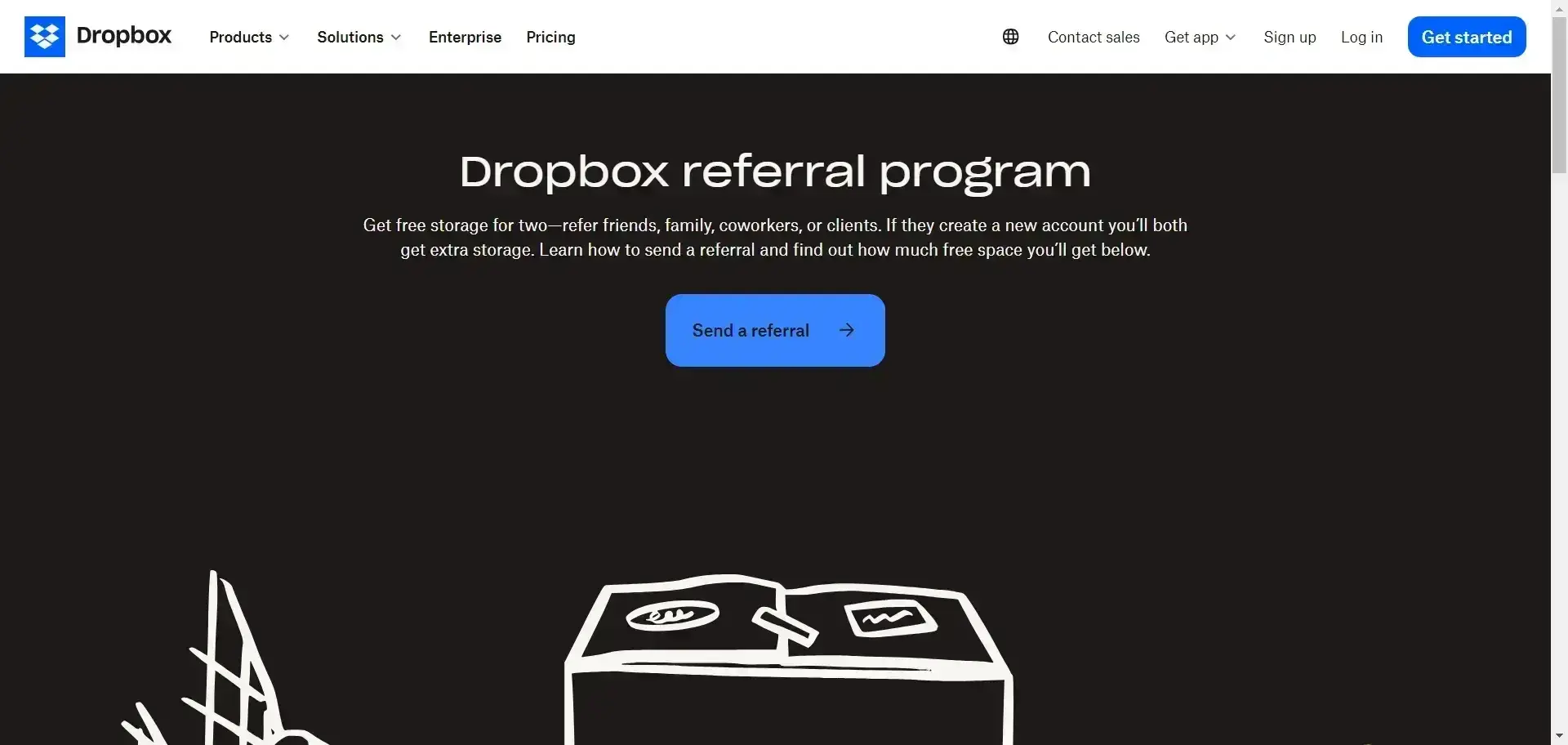
Increase customer lifetime value (CLV).
The customers you acquire through your referral program are inherently more loyal and more profitable than those who come in from traditional channels. Once again, it comes down to trust. When a friend or family member refers someone, they come to your brand with more openness and trust, which translates to increased spending and lower churn rates. On average, the CLV of referred customers is 16% higher than that of non-referred customers.
Referred customers are also four times more likely to refer others, creating a self-sustaining referral loop of loyal customers who bring in new customers, and those new customers become loyal customers as well.
I’ve seen this play out directly with my band. Fans who discover us through friends are noticeably more passionate and come to more shows than those who stumble upon our music through a Spotify playlist. In my experience, the difference is a powerful social aspect. Being a fan of a band or artist is something that people can share, and that emotional connection is what locks in loyalty and elevates the value.
This social component isn’t unique to music. For any business, referrals activate a social fabric of shared identity and community centered around your brand, making for loyal customers who are willing to spend more and advocate on your behalf.
Customer Referral Program Ideas
1. Contests or Giveaways
I’ll admit it, I’m a sucker for a giveaway contest. For me, the excitement of potentially winning a big prize is more attractive than the guarantee of a small referral incentive. Take Robinhood’s referral program, for example.

They offer a chance to win between $5 and $200 worth of stock for you and each friend who signs up. $200 is a big chunk of change, and my eyes go right to that number when I check out Robinhood’s referral offer. However, if you look at the fine print, you’ll see that there’s a 99% chance that your reward will only be $5 worth of stock. Essentially, it’s a guaranteed $5 incentive, which is nice, but perhaps not enough to motivate people to evangelize. Turning it into a contest with the chance to win up to $200 takes the incentive to the next level, even though the odds of winning big are actually much less than 1%.
The Risk (and My Recommendation)
High-energy contests with eye-popping rewards run the risk of attracting low-quality leads. If the incentives are juicy enough, people will just refer random acquaintances for the chance to win, which doesn’t do your team any favors.
That’s why I recommend tying your rewards to conversion events, rather than just email sign-ups. You’ll notice that Robinhood doesn’t reward you when a referral signs up. They have to connect their bank account, which is a significant conversion event that defines a real customer with the intent to spend.
Why It’s Effective
This tactic leverages powerful psychological triggers, such as the desire to win and the fear of missing out (FOMO). If you run a contest for a limited time, it creates additional urgency that drives people to act fast before time runs out.
Who It’s Best For
This works for any business that can offer an attractive prize.
- Retail brands can offer high-value items, exclusive bundles, or credit as incentives.
- Saas companies can offer free months of service or upgrades to higher product tiers.
How to Measure the Program’s Success
Since contests and giveaways can attract many leads, and not all of them are qualified, it’s best not to track success by just looking at the total number of referrals. Instead, it’s essential to track the estimated CLV of new customers acquired from the referral program and compare that number to the program’s cost.
When to Implement It
A contest or giveaway can inject energy into your referral program if numbers are plateauing or dipping. Additionally, lining up a giveaway or contest with the release of a new product is a great way to create hype and gain new leads who might buy your product anyway if they don’t win.
2. Social Gifting
Social gifting is a referral strategy that rewards customers for sharing a gift with their friends, rather than just prompting them for sign-ups. It’s also known as a dual-sided reward structure, and the idea is that both you and the person you refer receive a reward.
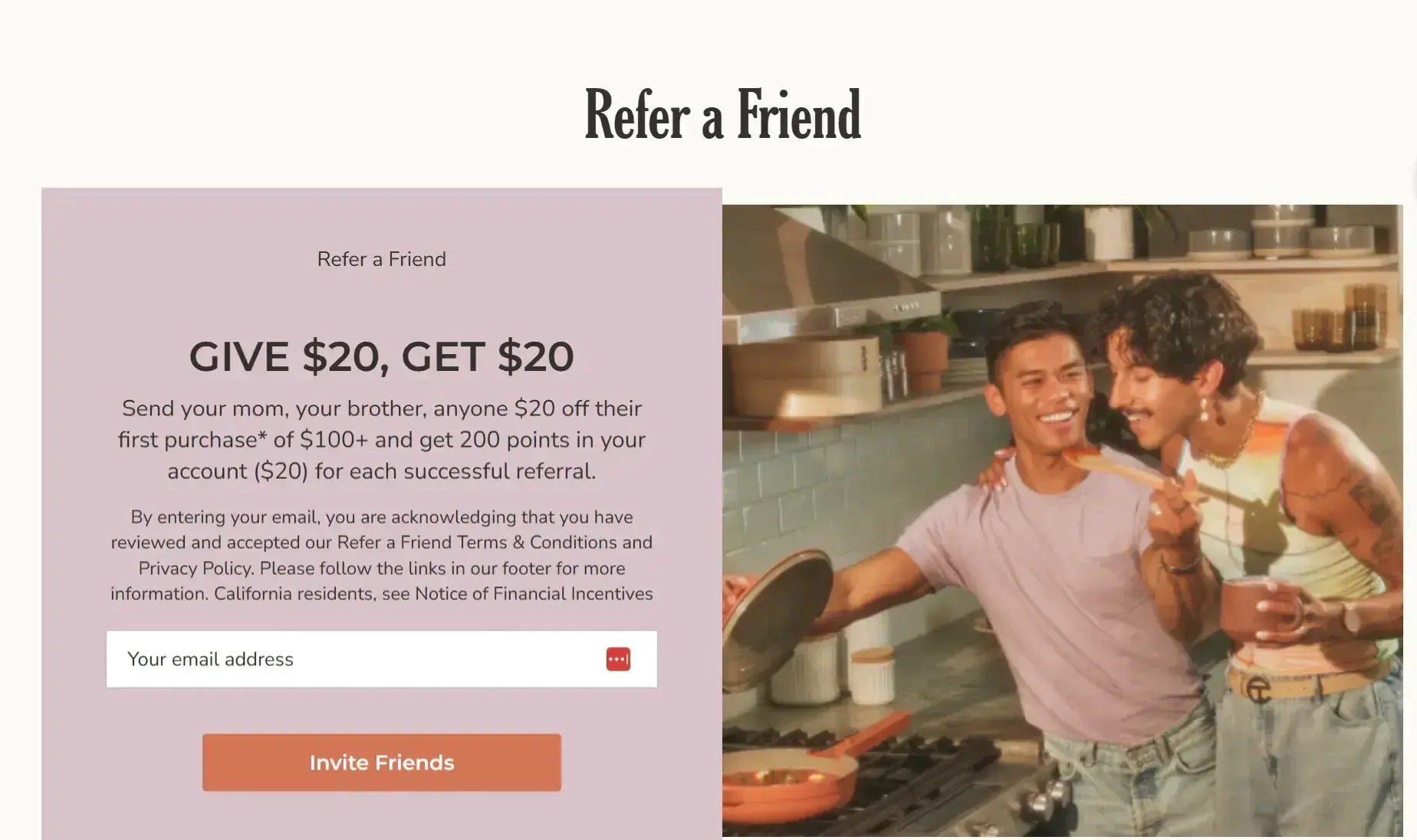
Take Our Place’s referral program, for example. Instead of just offering you a bonus when your friend signs up, Our Place lets you gift a friend a $20 discount off their first purchase. If they take advantage of it, you get reward points. Win-win.
Why It’s Effective
Social gifting turns the referral into an act of genuine generosity. As the referrer, I feel good about helping out a friend with a discount, and I get rewarded for my efforts. It minimizes the icky feeling that comes with selfishly hunting for a referral. Instead of selling something to a friend, I’m gifting them a genuinely good deal, and we both win.
Who It’s Best For
Social gifting is an ideal strategy for almost all brands. In my view, most referral structures should reward both participants, and those that offer single-sided rewards are less common in today’s referral marketing environment.
If you have a brand that doesn’t typically run sales, a social gifting referral program can be especially effective, since the referral program may be one of the few opportunities to receive a discount.
How to Measure the Program’s Success
Track referrals with unique coupon codes and referral links. With that tracking information, you can calculate your Referral Conversion Rate, which compares the number of times a referral link is shared or clicked with the frequency at which it’s actually redeemed.
Formula:
(Number of Referral Link Conversions / Number of Referral Link Shares or Clicks) x 100
A high conversion rate indicates that your incentive is valuable and that there is minimal friction in your conversion process.
When to Implement It
Social gifting is effective year-round, but it especially shines during the holiday season when the spirit of giving is in the air.
3. Donation-Based Referrals
I believe that the strongest customer loyalty is built on shared values. People want to feel good about where they spend their money and align themselves with organizations that represent the things they care about.
By getting involved with causes that customers care about, you can strengthen emotional ties and encourage them to share your brand with others.
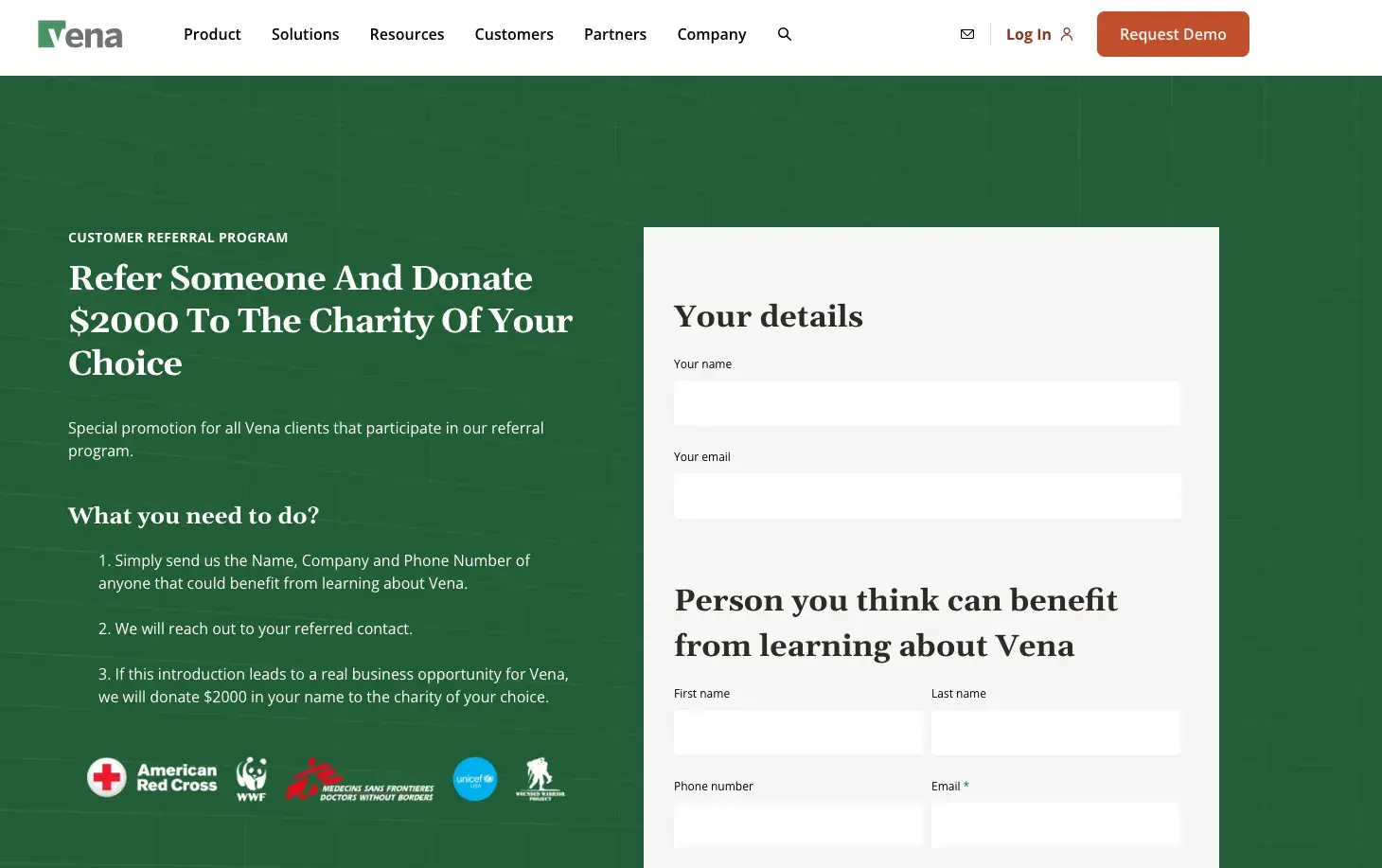
Instead of offering a referral discount, you can promise a charitable donation for every successful customer referral. Take Vena Solutions, for example. They are an enterprise software company that offers a $2,000 donation to the charity of your choice upon a successful referral.
Why It’s Effective
Using charity as a referral incentive is an effective strategy because it aligns with customers’ values and makes them feel good about doing business with you. It takes the focus off your brand and your product and places it onto a worthy cause. Often, this results in high-quality leads who are already deeply aligned with your brand’s culture and values.
Who It’s Best For
A donation-based referral program is often best suited for B2B companies, where clients are other businesses that are less concerned with saving a few bucks or getting free swag and are more interested in ensuring their money is going to a good cause.
How to Measure the Program’s Success
You can track the direct referrals of your donation-based referral program, and, of course, the more the merrier. However, I don’t think that’s the leading indicator of success with this strategy.
Instead, I recommend the following metrics:
- Referred Customer Lifetime Value (CLV). If your referred customers (brought in by shared values) spend more, churn less, and stick around longer than other customers, that is a huge success.
- Brand Sentiment. Monitor brand mentions online to gauge the goodwill your charitable referral campaign is generating. If the public perception of your brand improves as a result of your donation-based referral program, that’s a clear win.
When to Implement It
Donation-based referral programs are effective year-round, but it’s worth giving it a push during the holidays when people are feeling generous (and maximizing tax deductions).
4. Tiered Referral Program
So far, I’ve discussed referral programs that offer a flat, transactional reward for an individual referral. It’s a gear strategy, and it can even encourage customers to refer multiple friends. However, I’ve discovered that tiered referral programs are even more effective at encouraging numerous referrals.
Similar to a traditional customer loyalty program, a tiered referral program rewards individuals successively as they refer more people, allowing them to unlock increasingly valuable rewards and status as they climb the loyalty ladder. Take Morning Brew, for example:
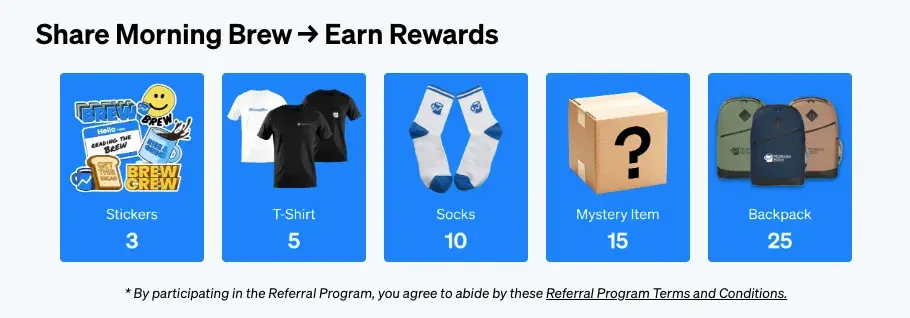
Morning Brew is a daily business newsletter that I read every morning, and the success of their Refer-a-Friend program is legendary. They employ a tiered referral program structure based on the number of successful sign-ups you generate. Three referrals get you some free stickers, but 25 referrals earn you a custom Morning Brew backpack, and 1,000 referrals get you a free trip to Brew HQ.
Why It’s Effective
Tier-based referral programs are effective because they appeal to human psychology:
- Gamification. Loyalty tiers transform the referral system into a game, where customers can “level up” and progress toward increasingly valuable prizes.
- Status and Exclusivity. Top loyalty tiers are challenging to achieve and therefore hold social value. People want to be part of an exclusive group, and that desire can be channeled into structured referral-based growth.
Who It’s Best For
Any company can benefit from a tiered loyalty structure. You can offer progressive discounts or increasingly rare merch and exclusive benefits that are unique to your company and product offerings. However, I think a tiered loyalty program is most effective for companies with high volume potential and low margin impact.
Take my Morning Brew example. Signing up for their newsletter is free, and getting referrals is as easy as encouraging readers to share a link. It’s a lot easier to convince someone to share a newsletter link than to get 30 friends to buy high-end cookware.
How to Measure the Program’s Success
Advocate efficiency is the primary metric to focus on here. You want to maximize the number of referrals that your highest-tier VIP members are generating, and it should be significantly higher than that of basic-tier members.
Suppose you reach a saturation point where you have too many high-tier members who aren’t generating enough conversions. In that case, you might need to consider adding a new tier, increasing referral requirements, or rethinking the program altogether.
When to Implement It
A tiered referral program is an evergreen system, so it’s less critical that you optimize the launch time and more crucial that you are consistently drawing attention to your program.
5. Seasonal Campaigns
I’m a sucker for a seasonal campaign. Black Friday deals, holiday sales, and especially spooky Halloween-based promotions always catch my attention. Part of it is the fun of it all. I love a pumpkin-scented candle as much as the next person. Still, the real driver is a sense of urgency. Knowing that this deal or promotion will soon be gone makes me more likely to bust out my credit card or refer a friend for a juicy discount.
The mechanism of your referral program is standard, but it’s supercharged by urgency and seasonal relevance. Often, businesses will offer increased incentives compared to the rest of the year to highlight the time-sensitive nature or holiday theme. For example, you might offer a $50 referral bonus only for the month of October.
Why It’s Effective
Spending habits tend to accelerate around major holidays, and people often seek discounts and deals to guide their spending. By offering juiced-up referral incentives and framing rewards as a limited-time opportunity, you can capitalize on the powerful psychological driver of urgency that encourages people to act now before it’s too late.
If you really nail it, customers will look forward to your seasonal referral program throughout the year.
Who It’s Best For
Seasonal campaigns can work for almost any company. The key is to nail the messaging, communicate scarcity, and align your incentives and/or product with a seasonal theme.
How to Measure the Program’s Success
Since seasonal referral programs are finite in nature, tracking their success is simple. You can measure referrals generated over your campaign period compared to the rest of the year. Your leads from a seasonal campaign should convert at a higher rate compared to standard referrals.
When to Implement It
Seasonal campaigns are most effective when implemented around major holidays, particularly those that coincide with increased consumer spending. Plan your seasonal campaign months in advance and implement it at least three to four weeks before the event or holiday, so people have a chance to discover the offer and make referrals.
6. Exclusive Events
In my experience, people’s desire for special experiences and exclusive events is a powerful motivator, often stronger than a discount or free T-shirt. That’s why Juice (my band) offers our most dedicated fans the opportunity to meet the band, watch our sound check, and enjoy an exclusive sidestage viewing experience as part of a VIP package.
These types of experiences aren’t just for bands and artists. You can offer access to an exclusive event as part of your referral program.
Why It’s Effective
Exclusive events offer something that discounts and freebies don’t: an experience. It’s something uniquely valuable that customers can’t buy on their own, and the exclusivity factor makes it very enticing. Additionally, exclusive events make loyal customers feel valued and strengthen the emotional connection with your brand.
Depending on the structure of your incentive, there may also be a social gifting aspect. You can host a special event, such as a dinner, for your most loyal clients and offer them extra tickets or a plus-one invitation, explicitly designated for friends or peers to be introduced to your brand as referrals.
Who It’s Best For
This referral strategy is best suited for B2B and high-value/luxury brands that can invest significantly to create a fantastic event experience.
- B2B companies, such as SaaS and consulting firms, can expand their networks through exclusive industry events. It’s easy for clients to convince peers to attend if it’s a great networking opportunity.
- High-value and luxury brands can really play into the exclusivity of special events. Think fashion events and luxury galas.
How to Measure the Program’s Success
Event ROI is a considerable measure of success. A big B2B networking and referral event won’t be cheap, so businesses can measure success by comparing total spending on the event with the value of new deals and clients closed as a result.
Referral quality is also a key metric. Referral leads from exclusive events should be very high quality, so I’d expect to see a high conversion rate and high CLV of accounts garnered through an exclusive referral event.
When to Implement It
You can host an exclusive event at any time of year, but avoid the busy season, which varies by industry. Typically, people have their calendars open immediately following the holiday season (January/February).
7. Referral Discounts
When it comes to referral incentives, the most common strategy is to offer discounts. The standard method is a flat discount, meaning a fixed reward for a single referral (e.g., $20 off for you and your friend when they sign up).
Another option is a Tiered Referral Discount Strategy, which I recommend for its effectiveness in encouraging repeated advocacy. A tiered referral discount strategy links larger discounts to higher numbers of referrals. For example, one referral grants you 20% off, but three referrals get you 35% off, and 10 referrals get you a free product.
Why It’s Effective
Everybody loves a discount, and a significant enough discount on a product that people genuinely want can convince them to leverage their connections and make a purchase. If the discount is substantial enough, customers will feel the reward is proportional to the effort of advocacy.
Who It’s Best For
Referral discounts are a tried and true method for almost any business, but they make the most sense for slightly higher-ticket items, such as clothing or electronics. For example, a 30% discount on a laptop is significantly more substantial than 30% off a latte. Actually, with the latte prices here in Brooklyn, that might not be the best example, but you get the point.
How to Measure the Program’s Success
It takes money to make money. At least that’s what I say when my bandmates insist on buying $300 of Sweetgreen on the company card. The same applies to your business’s ROI with referral discounts. Success means that the additional revenue from new referral customers significantly surpasses the cost of offering discounts.
When to Implement It
Referral discounts are an effective strategy at any time, but you can supercharge your referral discounts by lining them up with the release of new products. For example, when my band releases a new line of merchandise and announces a tour, we always coincide the push with an increased referral incentive.
8. Product or Service Upgrades
Instead of discounts or cash rewards, it makes sense for some businesses to offer enhanced utility through product or service upgrades in exchange for referrals. The classic example is Dropbox, which offers 500MB of additional storage space to Basic Users for successful referrals.
I’ve talked about Dropbox a lot already (and I will again later), so here’s another example:

I use Wealthfront for their High-Yield Savings Account, which offers a competitive 3.75% APY. Instead of cash rewards, their referral incentive is a 0.50% APY boost for 3 months, which is an attractive upgrade to a product I already use. Don’t get me wrong, I like a cash reward, but I also dig a product-based incentive like this one that keeps me invested in the ecosystem.
Why It’s Effective
Product and service-based incentives are effective because they add value without necessarily increasing cost. For example, a SaaS company can reward customers with additional seats for a referral. The marginal cost of these digital features is minimal compared to the CLV of the new customer acquired.
Who It’s Best For
Product and service upgrade-based incentives are most effective for SaaS platforms, FinTech, and any company that offers a digital product with measurable utility.
How to Measure the Program’s Success
Customer lifetime value (CLV) is a valuable success metric for this type of referral incentive. Since product and service upgrades deepen user engagement with your product, success would show up as increased CLV for customers who participate in the referral program.
When to Implement It
Companies with longstanding upgrade-based referral incentives, such as Dropbox, have proven this to be an effective, evergreen, and low-maintenance strategy.
However, consider boosting these incentives around the launch of new features and additional products.
9. Mystery Gifts
People are intrigued by the unknown, and you can leverage that natural human curiosity by offering a mystery gift or surprise reward. As long as you clearly communicate the potential value of your mystery gift, it can be a highly effective incentive.
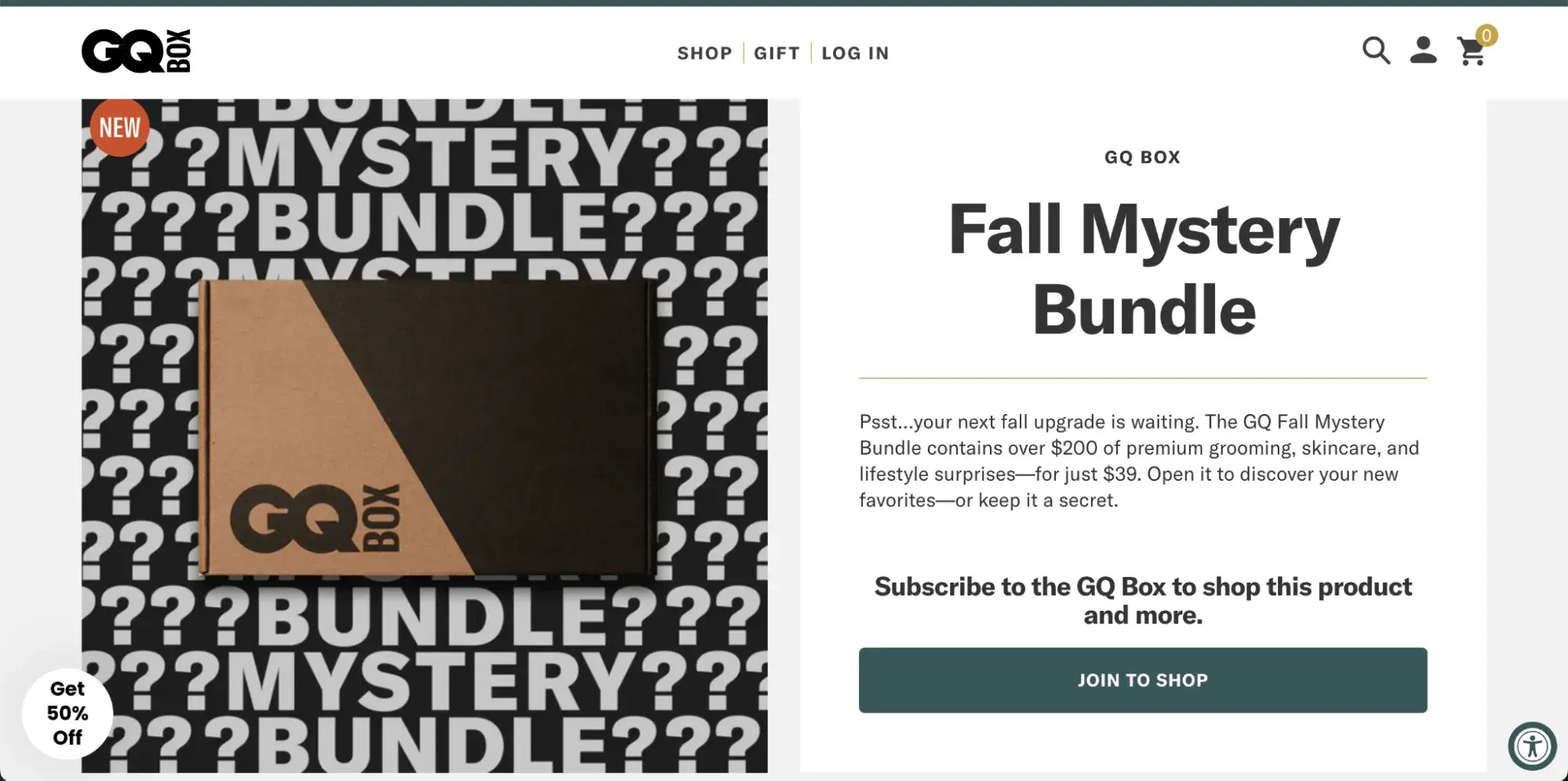
Many ecommerce brands use this concept to generate sales, such as GQ’s Fall Mystery bundle, which includes $200 worth of products for $39. I’m tempted to buy one as I write this. However, the best example of a mystery-based referral incentive is the Robinhood mystery stock reward I mentioned above, where you receive a surprise stock valued anywhere from $5 to $200. Hint: It’s usually $5.
Why It’s Effective
Mystery gifts tap into human curiosity. The desire to know the unknown is a powerful motivator. It’s also a powerful motivator to potentially get fantastic value. That’s where gamification comes in. If you offer a mystery gift with a range of values, it turns the referral incentive into a lottery ticket of sorts, where customers can win big or maybe (most likely) get a few stickers.
Who It’s Best For
Any business can leverage curiosity to create an intriguing referral incentive, but the mystery box strategy is most effective for ecommerce brands that sell physical goods. It’s a perfect opportunity to give away branded company swag, or even thin out extra inventory.
Digital and FinTech platforms have also achieved success with the mystery referral reward, as seen in the Robinhood example I previously discussed.
How to Measure the Program’s Success
Like all referral programs, return on investment (ROI) is key. However, a crucial and unique metric for this strategy is social media mentions and user generated content (UGC). If your mystery gift program is a success, people will want to talk about it online. Specifically, if users are posting pics and videos of themselves revealing their mystery gift, that’s a huge indicator that your program has achieved excitement and viral buzz.
When to Implement It
It’s challenging to sustain a mystery-based referral program in the long term, so I recommend implementing it in a limited capacity. It makes sense to launch a mystery gift-based referral program around holidays, product launches, and other significant events.
Referral Program Examples
1. Dropbox
Dropbox is the paragon of referral marketing success. Using a simple product-based, dual-sided incentive structure, the cloud storage icon achieved an eye-watering 3,900% user growth in 15 months.

Specifically, Dropbox offers free storage for both you and your referral. Dropbox basic users receive 500MB for every referral, while Plus users receive 1GB for every friend they bring on board.
What I Like
- Dropbox’s storage bonus is permanent, unlike other product-based incentives I’ve seen that expire after a set amount of time.
- The perceived value of free storage is relatively high, considering the cost of a little extra server load is negligible for Dropbox.
2. Acorns
Acorns is a FinTech investing app that I really like. It makes investing simple for everyone by allowing you to “round up” your credit card transactions and deposit the remainder into an automatically managed brokerage account tailored to your investment risk profile.
As for their referral program, they speak a universal language: cold, hard cash. Acorns users can earn $500 with just two successful referrals.

What I Like
- $500 is no joke. It’s enough of an incentive for me to share.
- Acorns updates its referral bonuses frequently. I’ve seen them offer up to $1,400 for six referrals. The frequent incentive updates keep their program fresh, even if it’s just cash every time.
3. Hostinger

Hostinger is a trusted web hosting provider that offers an attractive referral incentive of up to $450, along with 20% off for the friend who signs up. Specifically, Hostinger offers a 20% commission on the purchase price of each referral, so you can earn much more than $450 if you sling those referral links.
What I Like
- Hostinger turns existing customers into a sales team by offering a 20% commission on referrals.
- Bonus cash is easily deposited via PayPal, Wire, or Hostinger credit.
- Hostinger leads with a $450 incentive, which is a smart move. It’s inherently more eye-catching than 20%, which is potentially a more valuable but less striking figure.
4. Rakuten
Rakuten is a popular shopping assistant app that offers cash back rewards on online purchases. Users are already savvy to maximizing rewards, so Rakuten offers a compelling $50 incentive for each referral.

If you check the fine print, you’ll see that rewards are only paid out if the referral makes a purchase of at least $50 with Rakuten. It’s a notable caveat, but because Rakuten stacks cash back rewards at over 3,500 online merchants, your friend was probably planning on buying that thing anyway.
Interestingly, Rakuten’s incentive is one-way, meaning the referral doesn’t get a bonus for signing up and using the app.
What I Like
- $50 is a compelling reward, especially for a company that doesn’t actually sell anything.
- There’s no earning cap, so highly motivated users and influencers can earn a substantial amount of money. With benefits like that, you’re sure to create brand evangelists.
5. Chase Sapphire
Chase leverages the high value of its rewards currency, Ultimate Rewards Points, to drive credit card applications. As a cardholder, I can earn 15,000 points for each friend who opens a Chase Sapphire card, with a cap of 100,000 points.
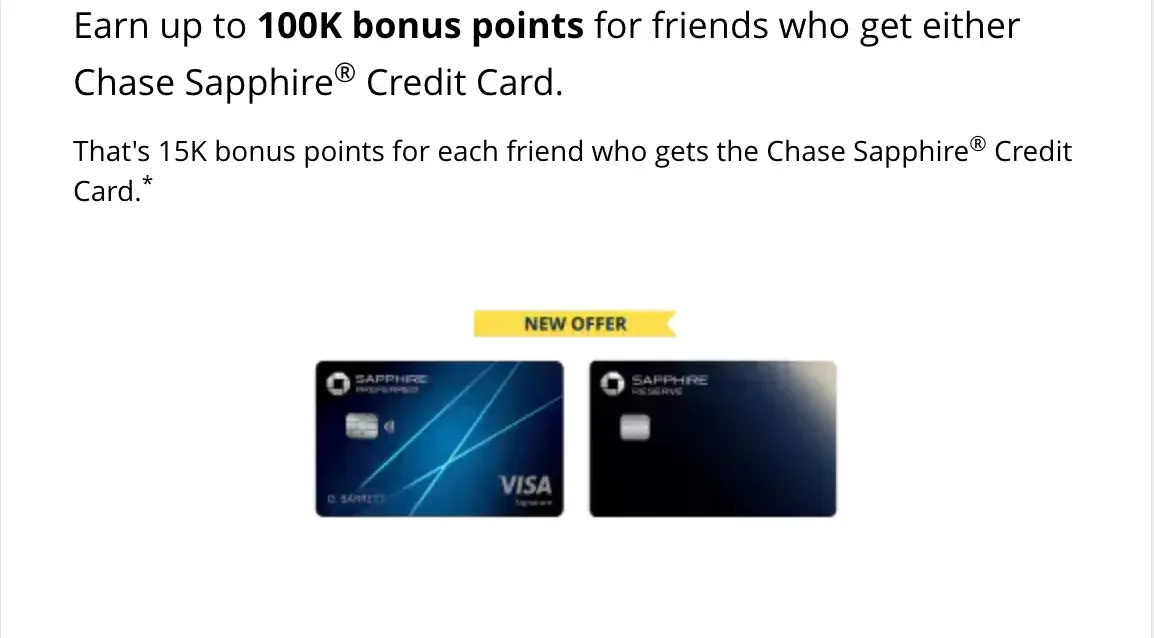
What I Like
- Chase Ultimate reward points are widely regarded as a flexible and valuable reward currency. I often transfer Chase points to airline and hotel partners to get the best travel deals.
- 100K is an eye-popping and generous number. It’s enough to motivate Chase Sapphire holders to evangelize their products.
- The Sapphire card is for people who are passionate about travel rewards, so it’s smart for them to offer the incentive in points instead of cash.
6. Pets Best
I love my dog so much. That’s why I got pet insurance to make sure I can take care of him whenever he needs it.

Pets Best is a pet insurance provider that leans into pet owners’ love for their furry friends.
Instead of a cash reward, Pets Best offers a $25 donation to animals in need for every referral. I actually use a different pet insurance provider, but this donation-based referral program makes me feel good about Pets Best as a brand.
Anyway, here’s a picture of my dog, Piggy, taking a nap next to me while I record bass at my desk:

What I Like
- Values-Driven Incentive: A donation-focused referral program makes people feel good about sharing a brand with friends. As a dog owner myself, Pets Best really pulls at my heartstrings with this one.
- Pets Best doesn’t limit its donation to referrals who buy a policy. They pay a donation when referrals receive a quote, which I think demonstrates their seriousness about their values.
7. Coinbase
Cryptocurrency exchange Coinbase offers a classic dual-sided incentive for its referral program.
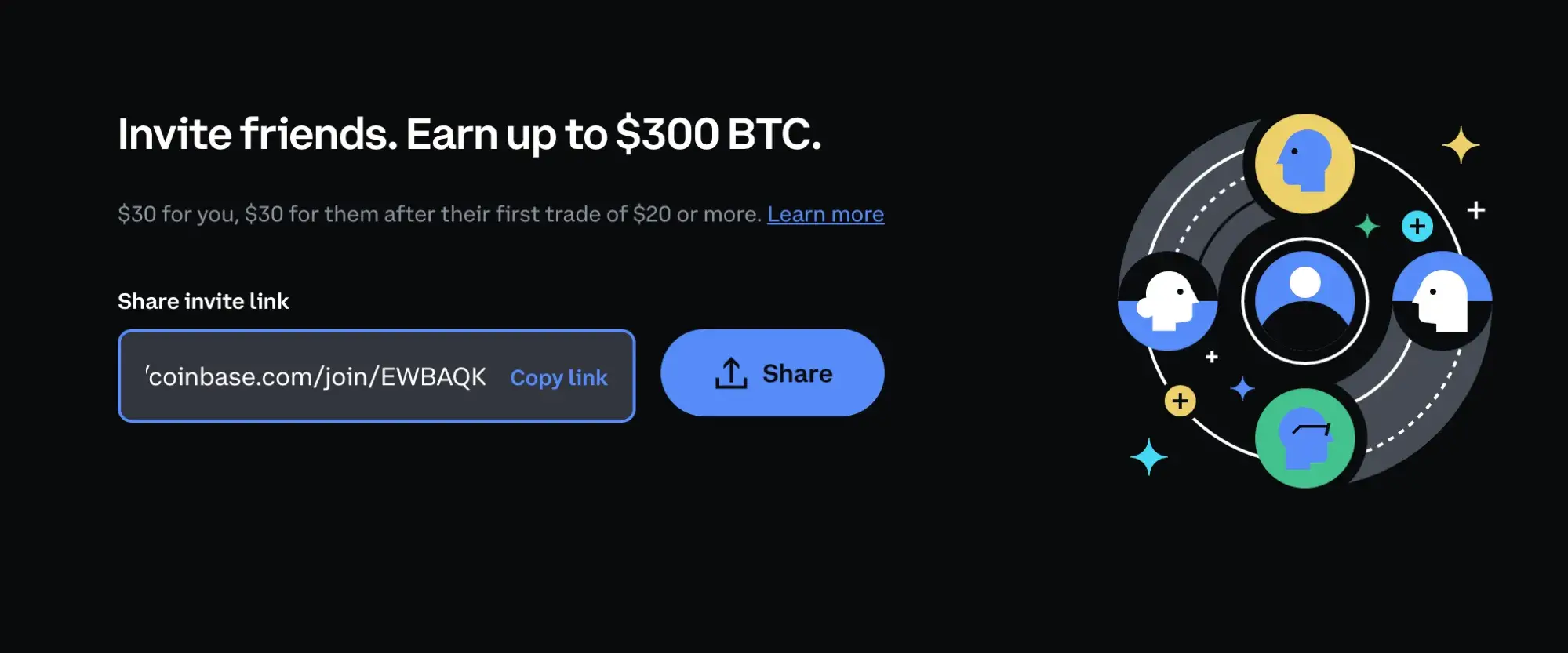
Coinbase’s users can earn up to $300 worth of Bitcoin, with $30 of BTC for each person in the event of a successful referral. I remember back in 2021 when Cryptos were pumping and GameStop Stock was going to the moon. Coinbase was running the same promotion back then, and I earned some nice rewards by referring all my bandmates to the platform. Thank you, Coinbase!
What I Like
Coinbase’s reward is tied to its core product: crypto. They could have offered a cash reward, but it makes sense to offer BTC. Crypto-savvy users are excited to receive it, and new users are compelled to engage with the product and learn about holding crypto from the outset.
8. NordVPN
NordVPN is a popular VPN service that protects your online privacy and security, with access to over 8,200 VPN servers. It lets you browse safely without the threat of phishing, scams, and malware.
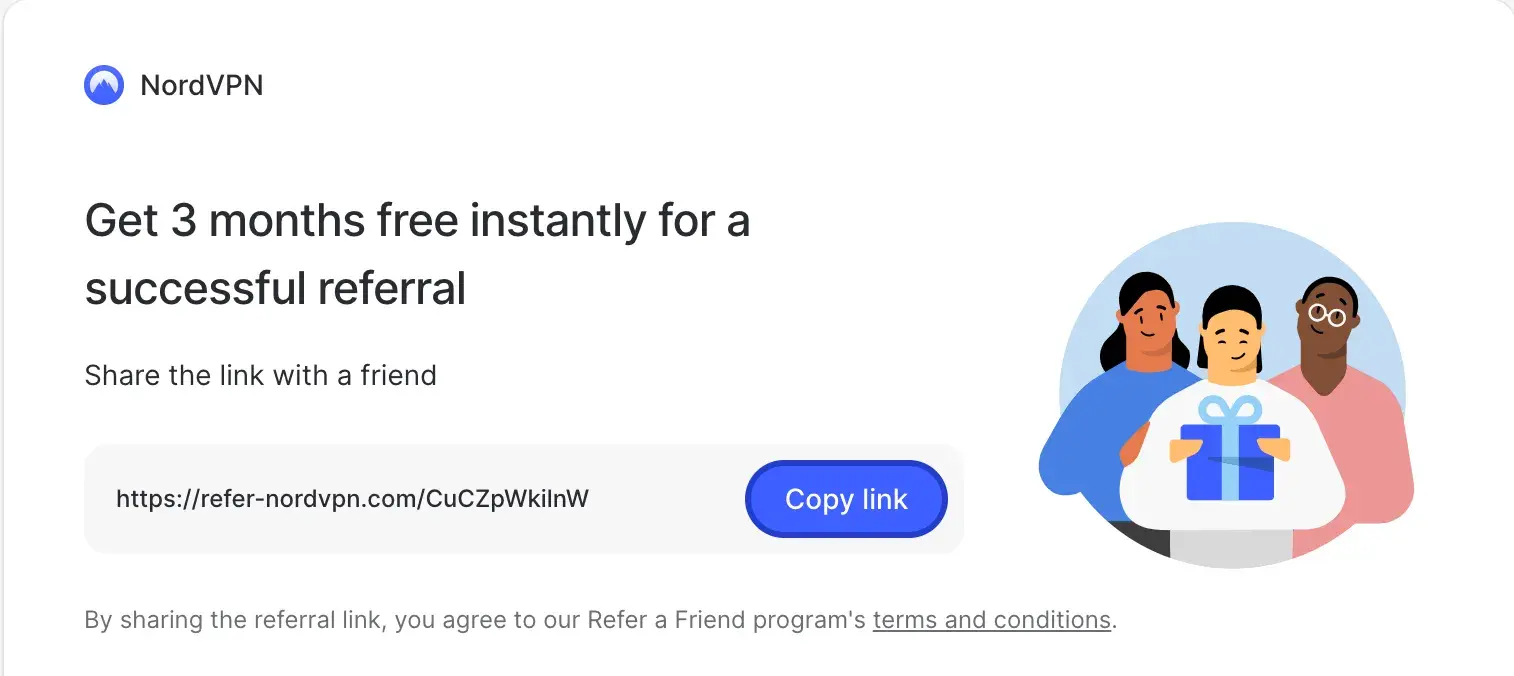
Similar to Dropbox, NordVPN offers a product-based referral program. The incentive is three months of free protection from NordVPN, and it’s a dual-sided incentive, just like Dropbox.
What I Like
It’s a simple incentive. Give three months, get three months. I also like that the reward is instant. With some programs, you must wait 30-90 days for your referral to be approved before incentives are paid. Not Nord, though. Both parties are rewarded immediately upon sign-up.
9. DoorDash
Food delivery company DoorDash is always seeking new drivers, and its client referral program is specifically designed to target areas with the highest demand.
Current drivers can check their app to see if drivers are needed in their area. If so, they’ll see a “Refer Friends” banner at the top of their screen.
They can then send referral links to friends interested in becoming DoorDash drivers, and when these new drivers complete the required number of deliveries, both the referrer and referee can earn cash bonuses.
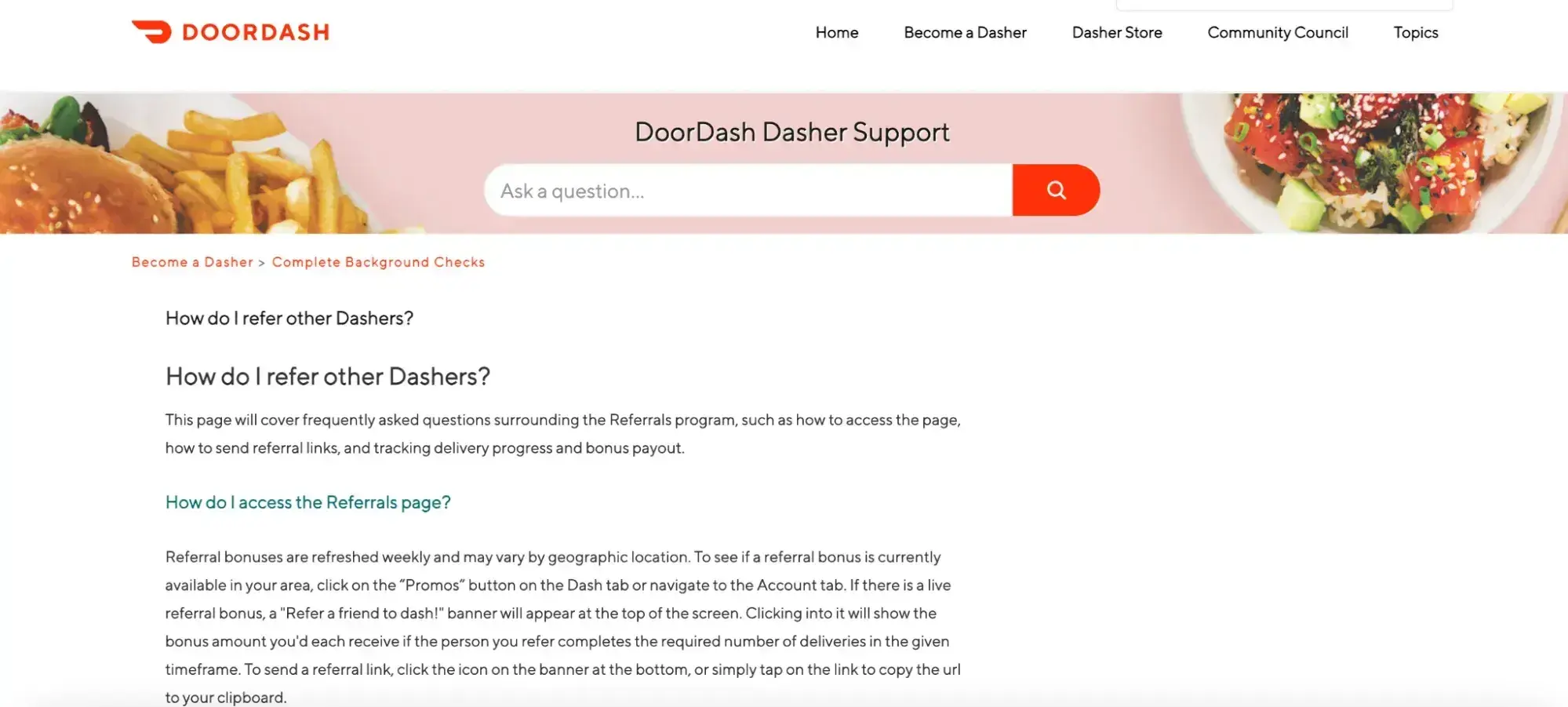
What I Like
I think it’s clever that DoorDash’s referral program dynamically activates based on demand for drivers in the area. Additionally, cash bonuses scale up dramatically in high-demand areas, allowing some lucky drivers to earn bonuses of up to $1,000. Since DoorDash dynamically serves its referral program based on geographic demand, it can save money and offer higher rewards where needed.
From Customers to Champions: Unlock the Power of Referrals
I think it’s funny that in the year 2025, the most effective marketing strategy is still just people telling their friends about stuff. The best referral programs tap into our natural inclination to share things we are excited about with the people around us, and it’s all underpinned by a foundation of trust and value. Offer a great product that people love, and maybe a little something to sweeten the deal (for both parties), and the referrals will start flowing in like water.
Customer referral programs are powerful because they activate your most loyal customers as brand advocates and salespeople. However, the most successful businesses know that it’s not just about making sales. The real goal is cultivating a self-sustaining ecosystem of loyal customers who remain committed for the long term.
Editor's note: This article was originally published in March 2018 and has since been updated for comprehensiveness.
Customer Acquisition
.png?width=112&height=112&name=Image%20Hackathon%20%E2%80%93%20Vertical%20(11).png)
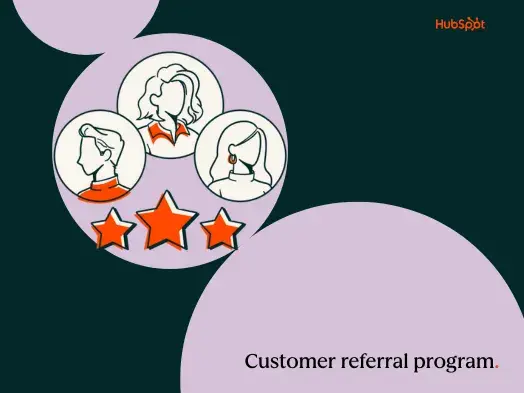
.png)

![7 Customer Acquisition Challenges You Might Face This Year [New Data]](https://53.fs1.hubspotusercontent-na1.net/hubfs/53/customer%20acquisition%20%20(1).webp)
